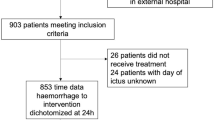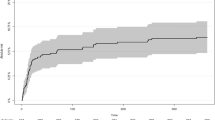Abstract
We retrospectively compared the outcome of aneurysmal subarachnoid hemorrhage (aSAH) patients treated in a neurosurgical ICU (nICU) between 1990 and 2005 with that of patients treated in a general ICU (gICU) between 2005 and 2013 with almost identical treatment strategies. Among other parameters, we registered the initial Hunt and Hess grade, Fisher score, the incidence of vasospasm, and outcome. A multivariate analysis (logistic regression model) was performed to adjust for different variables. In total, 755 patients were included in this study with 456 patients assigned to the nICU and 299 patients to the gICU. Multivariate logistic regression analysis revealed no significant difference between the patient outcome treated in a nICU versus gICU after adjusting for different variables. The outcome of patients after aSAH is not influenced by the type of ICU (gICU versus nICU). The data do not allow claiming that aSAH patients need to be treated in a specialized ICU for obtaining better results. Parameters which might differ from hospital to hospital, especially warranty of neurosurgical expertise on gICU, have the potential to influence the results.
Similar content being viewed by others
References
Aaslid R, Huber P, Nornes H (1984) Evaluation of cerebrovascular spasm with transcranial Doppler ultrasound. J Neurosurg 60:37–41
Bederson JB, Sander Connolly E, Batjer H, Dacey RG, Dion JE, Diringer MN et al (2009) Guidelines for the management of aneurysmal subarachnoid hemorrhage: a statement for healthcare professionals from a special writing group of the Stroke Council, American Heart Assocation. Stroke 40:994–1025
Dorhout Mees SM, Algra A, Vandertop WP, van Kooten F, Kuijsten HA, Boiten J, MASH-2 Study Group et al (2012) Magnesium for aneurysmal subarachnoid haemorrhage (MASH2): a randomised placebo-controlled trial. Lancet 380:44–49
Fisher CM, Kistler JP, Davis JM (1980) Relation of cerebral vasospasm to subarachnoid hemorrhage visualized by computerized tomographic scanning. Neurosurgery 6:1–9
Hunt WE, Hess RM (1968) Surgical risk as related to time of intervention in the repair of intracranial aneurysms. J Neurosurg 28:14–20
Ionita CC, Graffagnino C, Alexander MJ, Zaidat OO (2008) The value of CT angiography and transcranial Doppler sonography in triaging suspected cerebral vasospasm in SAH prior to endovascular therapy. Neurocrit Care 9:8–12
Jennett B, Bond M (1975) Assessment of outcome after severe brain damage. Lancet 1:480–484
Jones C (1979) Glasgow coma scale. Am J Nurs 79:1551–1553
Josephson SA, Douglas VC, Lawton MT, English JD, Smith WS, Ko NU (2010) Improvement in intensive care unit outcomes in patients with subarachnoid hemorrhage after initiation of neurointensivist co-management. J Neurosurg 112:626–630
Knopf L, Staff I, Gomes J, McCullough L (2012) Impact of a neurointensivist on outcomes in critically ill stroke patients. Neurocrit Care 16:63–71
Kramer AH, Zygun DA (2011) Do neurocritical care units save lives? Measuring the impact of specialized ICUs. Neurocrit Care 14:329–333
Kramer AH, Zygun DA (2014) Neurocritical care: why does it make a difference? Curr Opin Crit Care 20:174–181
Kurtz P, Fitts V, Sumer Z, Jalon H, Cooke J, Kvetan V, Mayer SA (2011) How does care differ for neurological patients admitted to a neurocritical care unit versus a general ICU? Neurocrit Care 15:477–480
Lerch C, Yonekawa Y, Muroi C, Bjeljac M, Keller E (2006) Specialized neurocritical care, severity grade, and outcome of patients with aneurysmal subarachnoid hemorrhage. Neurocrit Care 5:85–92
Lott JP, Iwashyna TJ, Christie JD, Asch DA, Kramer AA, Kahn JM (2009) Critical illness outcomes in specialty versus general intensive care units. Am J Respir Crit Care Med 179:676–683
Molyneux A, Kerr R, Stratton I, Sandercock P, Clarke M, Shrimpton J, International Subarachnoid Aneurysm Trial (ISAT) Collaborative Group et al (2002) International Subarachnoid Aneurysm Trial (ISAT) of neurosurgical clipping versus endovascular coiling in 2143 patients with ruptured intracranial aneurysms: a randomised trial. Lancet 360:1267–1274
Molyneux AJ, Kerr RS, Yu LM, Clarke M, Sneade M, Yarnold JA, International Subarachnoid Aneurysm Trial (ISAT) Collaborative Group et al (2005) International Subarachnoid Aneurysm Trial (ISAT) of neurosurgical clipping versus endovascular coiling in 2143 patients with ruptured intracranial aneurysms: a randomised comparison of effects on survival, dependency, seizures, rebleeding, subgroups, and aneurysm occlusion. Lancet 366:809–817
Molyneux AJ, Birks J, Clarke A, Sneade M, Kerr RS (2015) The durability of endovascular coiling versus neurosurgical clipping of ruptured cerebral aneurysms: 18 year follow-up of the UK cohort of the International Subarachnoid Aneurysm Trial (ISAT). Lancet 385:691–697
Polin RS, Coenen VA, Hansen CA, Shin P, Baskaya MK, Nanda A, Kassell NF (2000) Efficacy of transluminal angioplasty for the management of symptomatic cerebral vasospasm following aneurysmal subarachnoid hemorrhage. J Neurosurg 92:284–290
Samuels O, Webb A, Culler S, Martin K, Barrow D (2011) Impact of a dedicated neurocritical care team in treating patients with aneurysmal subarachnoid hemorrhage. Neurocrit Care 14:334–340
Sarpong Y, Nattanmai P, Schelp G, Bell R, Premkumar K, Stapleton E, McCormick A, Newey CR (2017) Improvement in quality metrics outcomes and patient and family satisfaction in a neurosciences intensive care unit after creation of a dedicated neurocritical care team. Crit Care Res Pract 2017:6394105
Wachter D, Hans F, Kreitschmann-Andermahr I, Rohde V (2011) Lower incidence of transcranial Doppler and symptomatic vasospasm after aneurysmal subarachnoid hemorrhage and aneurysm clipping in the elderly patient? Neurosurgery 69:261–266
Wachter D, Kreitschmann-Andermahr I, Gilsbach JM, Rohde V (2011) Early surgery of multiple versus singular aneurysms after subarachnoid hemorrhage—an increased risk for cerebral vasospasm? J Neurosurg 114:935–941
Wärme PE, Bergstrom R, Persson I (1991) Neurosurgical intensive care improves outcomes after head injury. Acta Neurochir 110:57–65
Author information
Authors and Affiliations
Corresponding author
Ethics declarations
Conflict of interest
The authors declare that they have no conflict of interest.
Ethical approval
The study was reviewed by the local ethics committee (ethics committee Georg-August-University Göttingen), but did not need approval because it was a retrospective analysis of anonymous data.
Informed consent
Not needed because of anonymous patient data
Additional information
The manuscript is submitted on behalf of all authors and all named authors have participated in this work.
Rights and permissions
About this article
Cite this article
Mielke, D., Malinova, V., Moerer, O. et al. Does the subspecialty of an intensive care unit (ICU) has an impact on outcome in patients suffering from aneurysmal subarachnoid hemorrhage?. Neurosurg Rev 42, 147–153 (2019). https://doi.org/10.1007/s10143-018-0973-x
Received:
Revised:
Accepted:
Published:
Issue Date:
DOI: https://doi.org/10.1007/s10143-018-0973-x




